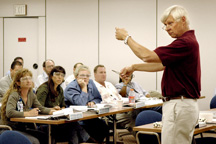
A renewed commitment to continuous learning is part of a new Strategic Education Plan that will encourage all employees to take up to 32 hours of classes that primarily focus on Sandia’s educational thrust areas. The plan paves the way for Sandia to reestablish a learning culture where education and career-long learning are valued parts of everyone’s job.
"Continuing education is critical to sustaining the technical and professional competency of both Sandia and its workforce," says VP 2000 John Stichman, who heads up the Strategic Education Committee that developed the Strategic Education Plan.
"At one time Sandia lived and breathed a culture of learning," John says. "Opportunities to learn and teach were abundant, and managers encouraged and expected their staff to participate. ‘Educational attainment’ was the standard for initial employment consideration and for reclassification consideration after a person was on board."
During the late 1980s and early 1990s focus on education as a critical element of Sandia’s success shifted, and an "ad hoc, marginal approach to education and training took the place of a strategically driven approach," John says. Also, Sandia developed a broader set of sponsors, each with specific needs. This, along with a move to reduce indirect costs across the Labs, resulted in a reduced emphasis on continuous learning.
Tom Blejwas, Director of Center 2500 and committee member, says the idea for a rebirth of an emphasis on education dates back several years when a team of directors self-organized to address how to recapture the culture of learning that once prevailed at Sandia.
Last year Executive VP Joan Woodard, acting on recommendations of that team, formed the Strategic Education Committee to bring education, as it supports the Labs’ mission, back into the spotlight. The committee members developed the education plan and Mission Council endorsed it earlier this year.
The plan begins with a vision in which Sandia is seen as a "national security learning environment – anticipating problems not yet imagined and answering questions not yet asked." John adds, "We envision that every Sandian will be passionate and excited to be part of this culture where continuing education is encouraged and rewarded."
One of the barriers noted by the Strategic Education Committee was a way for people to charge their time while participating in continuing education and taking career-broadening courses. The plan includes a provision for charging up to 32 hours of Continuous Learning and Sandia Instructor activities outside of current project needs.
Char Wells, Level II Manager of Corporate Education, Development, and Training (CEDT, Org. 3520), which works closely with the committee, says they have been working over the past three years to build up strong education and development programs and classes that meet employees’ needs. Employees in organizations 1000, 2000, and 6000 were surveyed to determine their education and training needs. The programs and courses identified by these organizations provide an important foundation for the larger Labs effort targeting education needed in the future – such as in the bioscience and nanotechnology areas.
"The courses are designed to help people at Sandia be more engaged in these key areas so critical to our global future and to Sandia as a whole," she says. "But it’s more than that. It’s a way to help course attendees prepare for the future, giving them skills and knowledge that will help them to look at a situation or problem in many different ways."
Most of the courses, which range from four hours to multiple weeks, fall into three categories – technical education (microsystems, photonic sciences, materials and process sciences, computational and information sciences, engineering sciences, pulsed power, surety science, bioscience, nano-science, project management, and manufacturing), business administration, and leadership/management development.
An important aspect of the new education plan is that it stresses the importance of Sandians teaching Sandians. "Sandia has its own way of doing things, and the courses taught at Sandia by Sandians emphasize that difference," Char says. "They are different from how they are taught, for example, at UNM. The emphasis is back to ‘continuous learning’ – coaching with Sandia
experience."
A wide selection of courses is available now, and a catalogue listing all the courses sponsored by Corporate, Education, Development, and Training is scheduled to be published next spring.
"I encourage employees and their managers not to wait," says John Stichman. "They should make a discussion of their planned learning experiences an important part of their objective-setting for the year."